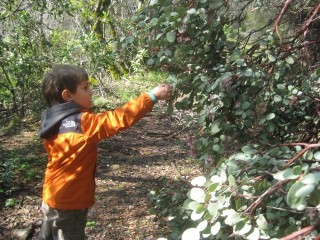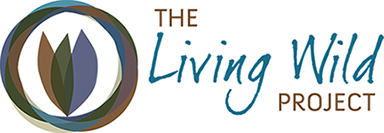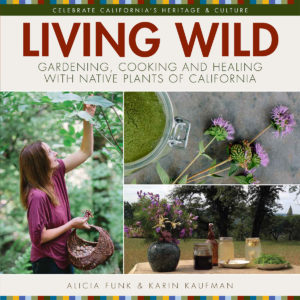Why Bother to Live Wild?
Welcome to the first seasonal blog for livingwild.org! I want to invite you to participate in this collaborative site by adding your recipes and plant discoveries. It is essential that we work together to revive the living libraries of information on how to live sustainably with this land. This will provide independence, health and food security for our grandchildren.
I believe strongly that it is worth taking time to grow and harvest your own native food and medicine, even though it certainly isn’t as convenient as going to the local grocery store.
The first key reason is that it moves us closer to a carbon-free lifestyle. The ingredients in the average American meal travels approximately 1,500 miles from farm to table. Oak trees can grow on steep hillsides without irrigation and produce up to 2, 000 pounds of acorns per tree per year. Native foods eliminate shipping and allow us to enjoy local food without the significant water, compost, fertilizers or fencing that is required for most food crops.
Secondly, native plants provide a 100% local source of healthy nutrition and medicine. I sent samples of some our local fruits and oak nuts to a laboratory for testing, since I was curious as to how our native crops compared to commercially popular antioxidant fruits. It turns out that our local Manzanita, Elderberry and Madrone are about 3 times higher in antioxidants than blueberries and pomegranates! Acorns (Oak Nuts), have more Omega-6, Vitamin A, Folate and Potassium than whole grain wheat flour, without the gluten.
In terms of health, indigenous people around the world have relied exclusively upon medicine from native plants for thousands of years, and in some cases, scientific studies have confirmed the efficacy of these traditional uses. For example, there is current research showing that preparations from our state flower, the California Poppy, are useful for stress and anxiety and it was also used by the Pomo Indians as a sedative to calm and soothe their babies.
The third reason to live wild is that it helps combat nature deficit disorder. The average American can identify over a thousand brand names but can’t name 10 indigenous plants or animals. Our children spend an average of 4.5 hours each day in front of tv’s and electronic devices, and their recess time and physical education classes are being reduced in our schools due to budget problems. I’ve included a section on seasonal activities for kids in the Living Wild book so we can enjoy more time outdoors with our families—identifying plants growing in our own backyard, tasting edible fruits or collecting acorns.
in front of tv’s and electronic devices, and their recess time and physical education classes are being reduced in our schools due to budget problems. I’ve included a section on seasonal activities for kids in the Living Wild book so we can enjoy more time outdoors with our families—identifying plants growing in our own backyard, tasting edible fruits or collecting acorns.
The fourth reason is to preserve cultural knowledge. Our local landscape of plants supported indigenous people without grocery stores for thousands of years. We’ve lost the Native Californians valuable “user’s manual” that could guide us to the plants we would enjoy eating, not just what we could eat to survive if we were lost in the woods. In the Living Wild book, I’ve included indigenous plant names in the Nisenan, Konkow and Mountain Maidu languages and their plant uses in an effort to regain some of this lost knowledge.
Finally, growing native plants helps protect biodiversity. Gardening with native plants creates habitat for bees, birds, hummingbirds and mammals. More than 6,300 native plant species grow here in California, a third of which grow nowhere else on earth. For example, 47 Manzanita species and 43 Ceanothus species occur only in California. In the Sierra Nevada, three native plants are already presumed extinct and over 100 are rare and threatened. By cultivating beneficial native plants we can help our own health as well as the health of the landscape around us.
What can we do to get started?
The community is invited to participate by sharing recipes and discoveries here at The Living Wild Project in the hope we can work together to grow independent, local food and medicine while conserving our planet’s remaining natural resources.




